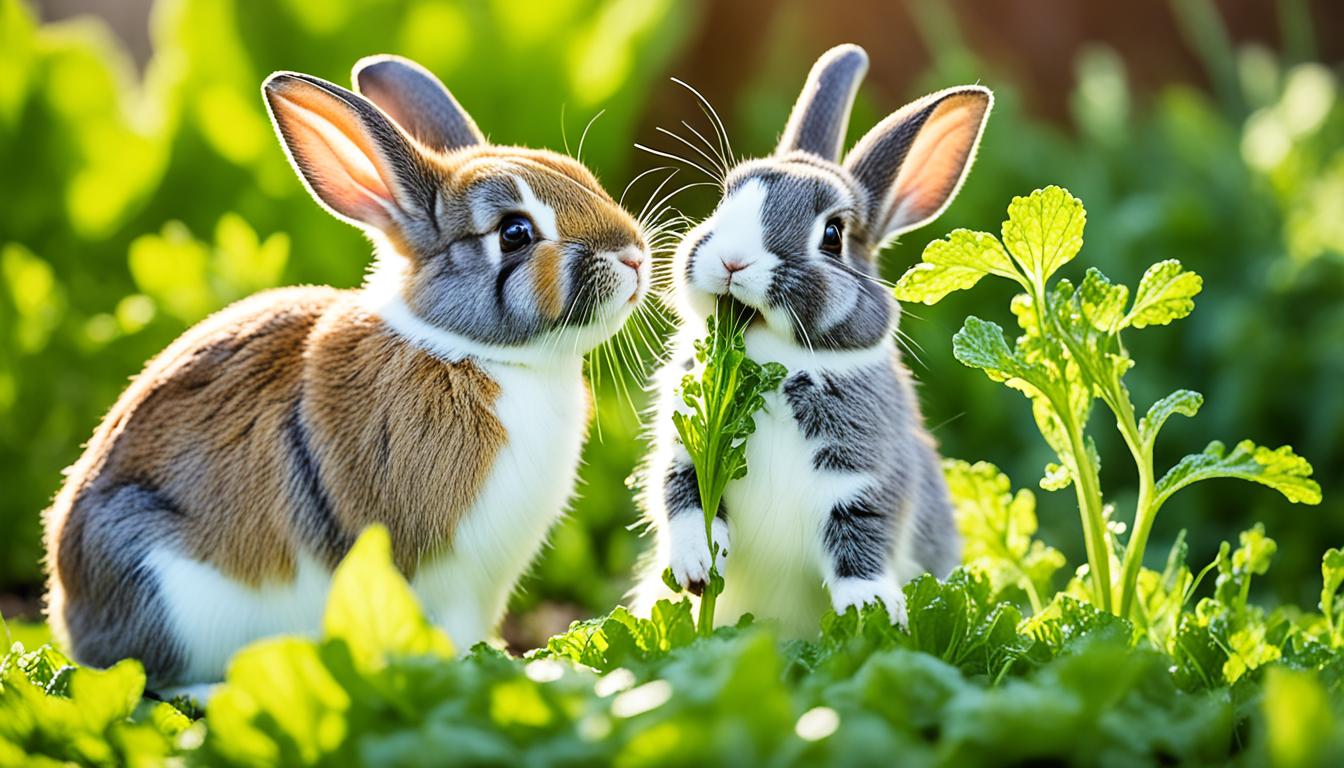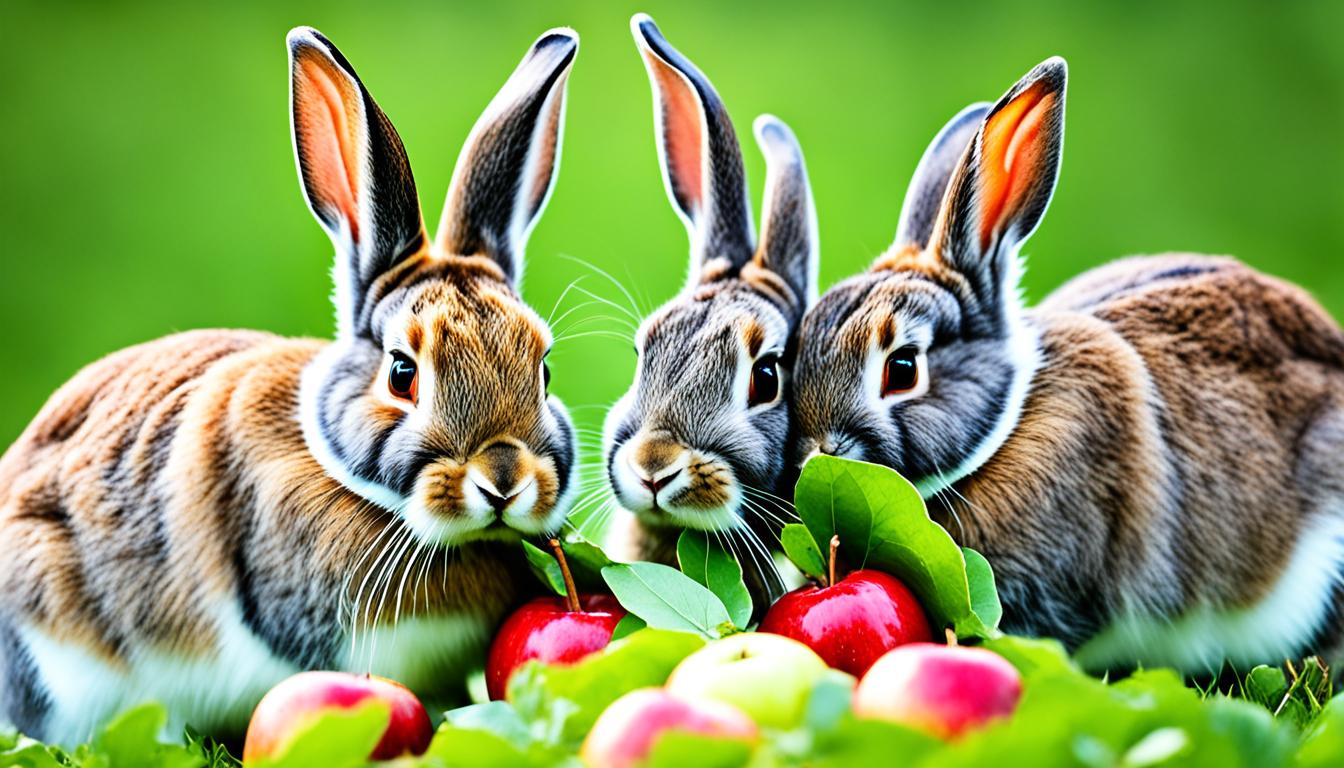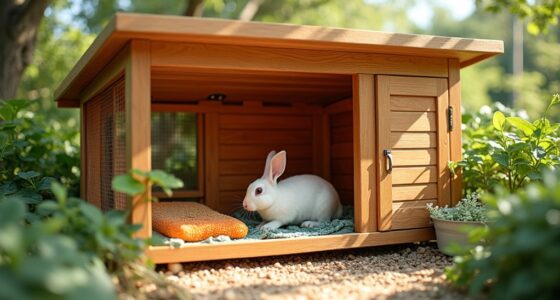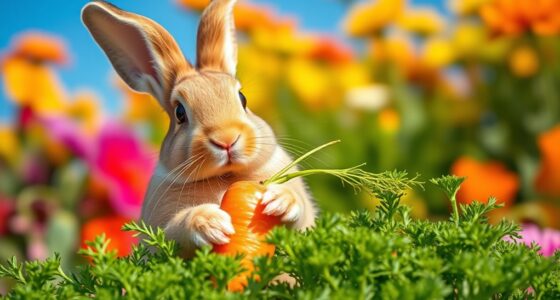Did you know that the diet of a rabbit is crucial for its overall well-being and lifespan? A balanced diet ensures that rabbits receive the necessary nutrients to thrive. When it comes to leafy greens and vegetables, one surprising inclusion is mustard greens. Yes, rabbits can eat mustard greens! This unexpected fact expands the options for diversifying your rabbit’s diet and giving them a variety of essential vitamins and minerals.
Mustard greens are not only safe for rabbits but also offer numerous nutritional benefits. They are packed with essential vitamins, including vitamins A, C, and K. These vitamins contribute to a rabbit’s immune system, bone health, and overall vitality. Additionally, mustard greens provide soluble fiber and trace minerals like iron, manganese, and copper, which are essential for a healthy and well-functioning digestive system.
However, as with any new addition to a rabbit’s diet, it’s important to introduce mustard greens gradually and in moderation. This helps ensure that your rabbit’s digestive system can adjust to the new food without any issues. Consulting with a veterinarian can provide you with personalized dietary recommendations and ensure that you’re making the best choices for your furry friend.
Key Takeaways:
- Mustard greens are a safe and nutritious option for rabbits.
- They contain essential vitamins and minerals that contribute to a rabbit’s overall health and well-being.
- Introduce mustard greens gradually to avoid digestive upset.
- Consult with a veterinarian for personalized dietary recommendations for your rabbit.
- Remember to provide a balanced diet consisting of grass hay, pellets, and a variety of leafy greens and vegetables.
The Importance of a Balanced Rabbit Diet
A balanced diet is crucial for the overall health of rabbits. One of the key components of a rabbit’s diet is fiber, which plays a vital role in maintaining proper digestion and preventing various health issues. A well-balanced diet ensures that rabbits receive all the necessary nutrients for their optimal well-being.
The foundation of a rabbit’s diet should consist of fresh grass hay, which provides not only fiber but also dental wear. Hay should make up the majority of their daily food intake, with an appropriate amount offered at all times. High-fiber grass hay options include timothy, orchard grass, and brome grass.
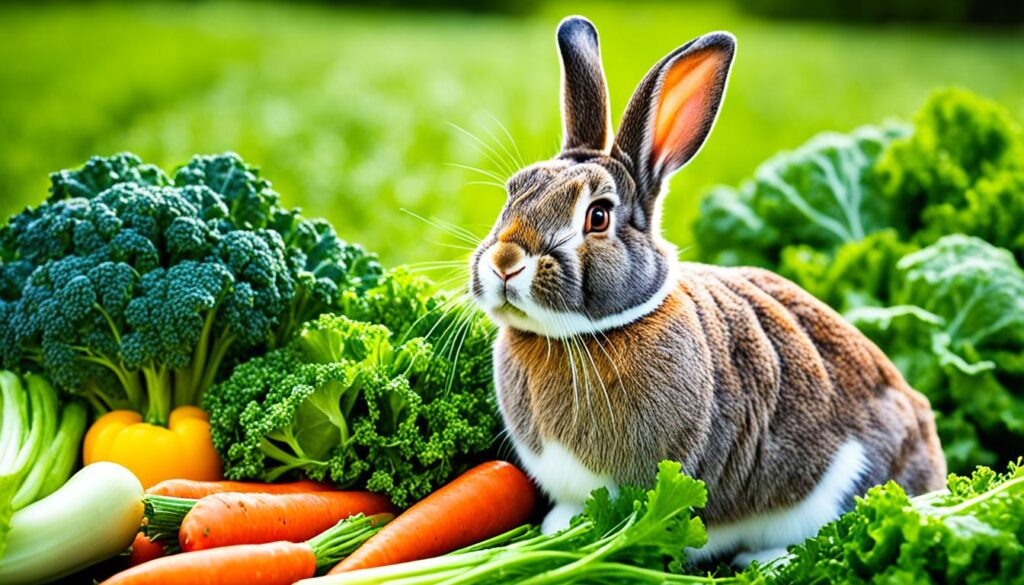
Supplementing hay, rabbits also benefit from a smaller portion of high-quality pellets. These pellets should be specifically formulated for rabbits, ensuring they contain the necessary nutrients without excessive fat or protein content. Pellets should make up a small portion of their diet and must be fed in controlled amounts to prevent obesity and related health problems.
In addition to hay and pellets, leafy greens and vegetables should be included in a rabbit’s diet to provide essential vitamins and minerals. This variety introduces different flavors and textures, making mealtime more enjoyable for rabbits and preventing dietary monotony.
The Benefits of Including Mustard Greens in a Balanced Diet
Mustard greens are an excellent addition to a rabbit’s diet, offering additional nutrients and enrichment. They are a good source of fiber and are packed with essential vitamins and minerals. Including mustard greens provides a refreshing variety to their diet and promotes overall health and well-being.
“A balanced diet is crucial for the overall health of rabbits.”
Key Points for a Balanced Rabbit Diet:
- Include fresh grass hay as the foundation of their diet.
- Offer a smaller portion of high-quality pellets.
- Incorporate a variety of leafy greens and vegetables.
- Introduce mustard greens for additional nutrients and enrichment.
Understanding the Nutritional Benefits of Mustard Greens for Rabbits
Mustard greens offer several nutritional benefits for rabbits. They are rich in vitamins A, C, and K, as well as provide soluble fiber and trace minerals such as iron, manganese, copper, and zinc. These nutrients contribute to a rabbit’s overall health and assist in functions like immune support, stress reduction, and maintaining healthy joints and skin.
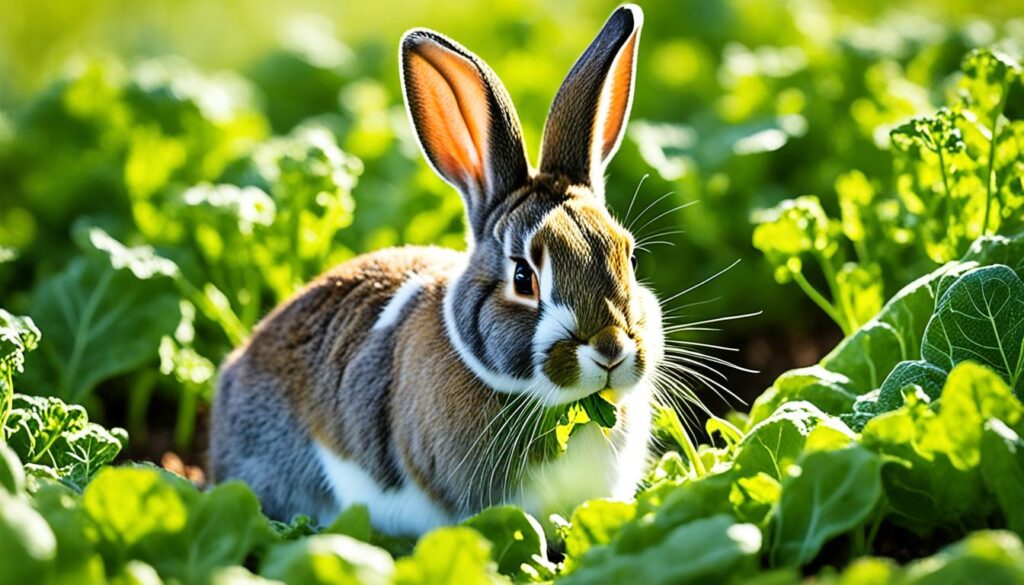
Recommended Greens and Veggies for Rabbits
When it comes to incorporating leafy greens and vegetables into a rabbit’s diet, variety is key. Offering a diverse range of greens and veggies ensures that your rabbit receives a wide array of essential nutrients. Some of the best options for rabbits include:
| Leafy Greens | Vegetables |
|---|---|
| Lettuce | Broccoli |
| Spinach | Celery |
| Kale | Bell Peppers |
| Watercress | Cabbage |
| Squash |
However, it’s important to note that certain greens like kale, spinach, and mustard greens should be fed in moderation due to their higher levels of oxalates. While they provide nutritional benefits, excessive consumption may lead to health issues in rabbits. As with any new food, observe your rabbit’s response and consult with a veterinarian if you have any concerns.
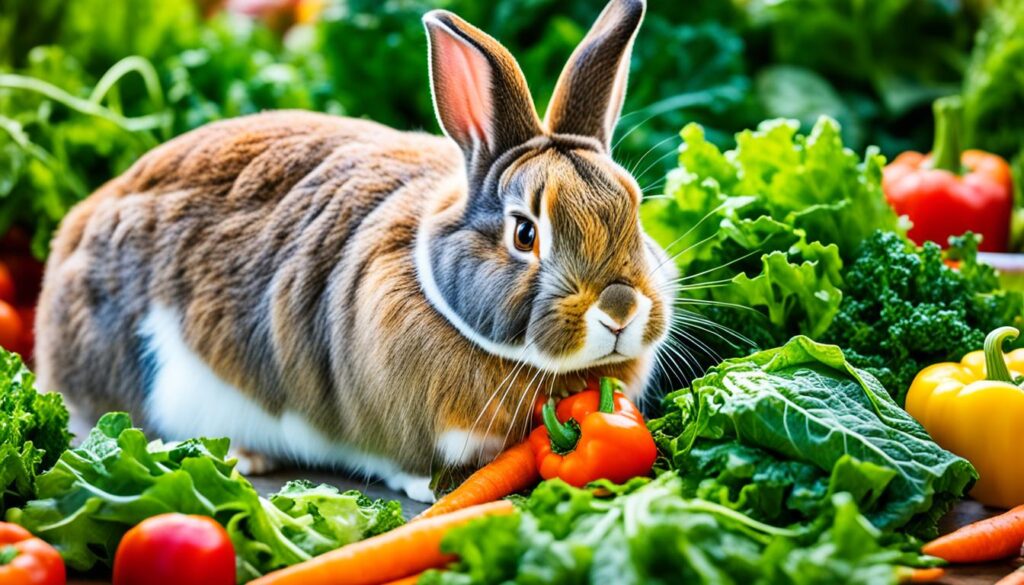
Why Variety Matters
Offering a variety of greens and veggies not only provides nutritional benefits but also adds enrichment to your rabbit’s diet. Different greens and vegetables offer unique flavors and textures, keeping mealtime interesting and stimulating for your bunny. Additionally, a diverse diet helps prevent selective eating habits and ensures that your rabbit receives a wide range of nutrients for optimal health.
Gradual Introduction and Feeding Guidelines
When introducing mustard greens or any new food to a rabbit, it’s important to do so gradually. Start with small amounts and monitor your rabbit for any signs of digestive upset. It’s also recommended to rotate the types and varieties of greens and veggies offered to provide enrichment and prevent rapid intake. Following feeding guidelines based on a rabbit’s weight can help ensure they receive the appropriate portion sizes.
Feeding Guidelines for Rabbits
| Rabbit’s Weight | Mustard Greens Portion Size |
|---|---|
| 2-4 pounds | 1-2 cups |
| 4-7 pounds | 2-3 cups |
| 7-10 pounds | 3-4 cups |
| 10+ pounds | 4-5 cups |
By following feeding guidelines based on your rabbit’s weight, you can ensure they receive the appropriate amount of mustard greens and other vegetables. Remember to introduce new foods gradually, as sudden changes in diet can cause digestive issues. If you’re uncertain or have any concerns, consult with a veterinarian for personalized dietary recommendations.
The Role of Pellets in a Rabbit’s Diet
Pellets play an important role in providing balanced nutrition for rabbits. These specially formulated food pellets are designed to meet a rabbit’s nutritional needs and ensure they receive all the essential vitamins and minerals necessary for optimal health.
However, it’s crucial to practice portion control when feeding pellets to your rabbit. Excessive consumption of pellets can lead to obesity, digestive issues, and other health problems. To avoid overfeeding, it’s vital to measure and control the amount of pellets given to your furry friend.
“Proper portion control is key to maintaining a healthy weight and preventing nutritional imbalances in rabbits.”
When selecting pellets for your rabbit, opt for high-quality options that provide a balanced mix of nutrients. Look for pellets that contain a minimum of 20-25% fiber, around 14% protein, and less than 1% calcium. These nutrient levels promote proper digestion, muscle development, and overall well-being for your rabbit.
As your rabbit’s diet should primarily consist of fresh grass hay, pellets should only make up a smaller portion of their daily food intake. The majority of their diet should be comprised of hay, leafy greens, and a variety of vegetables to ensure a well-rounded, balanced nutrition plan.
Gradual transition is essential when introducing pellets into your rabbit’s diet. Start by offering a small amount of pellets and gradually increase the quantity over a week or two. Simultaneously, gradually decrease the amount of pellets given as you increase the Rabbit’s intake of fresh vegetables and grass hay.

Tips for Portion Control and Balanced Nutrition:
- Measure the correct pellet portion specified by a veterinarian or the manufacturer based on your rabbit’s weight.
- Consult with a veterinarian to determine the appropriate pellet-to-vegetable ratio for your rabbit’s specific dietary needs.
- Ensure your rabbit has access to fresh, clean water at all times.
- Offer a variety of vegetables and leafy greens to ensure a diverse nutritional intake.
- Monitor your rabbit’s weight and adjust portion sizes accordingly to maintain a healthy body condition.
- Regularly check the expiration date of the pellets to ensure freshness and optimal nutritional content.
Remember, providing a well-balanced diet with portion-controlled pellet feeding is crucial for your rabbit’s overall health and well-being. By implementing these guidelines, you can help your furry friend thrive and enjoy a long, happy life.
Conclusion
In conclusion, rabbits can safely enjoy the addition of mustard greens as part of a balanced diet. These leafy greens, along with a variety of other vegetables, offer essential nutrients and enrichment for our furry friends. It’s important to introduce new foods gradually to avoid any digestive issues and to follow the recommended feeding guidelines based on your rabbit’s weight.
By incorporating mustard greens as part of a varied diet, we can provide our rabbits with important vitamins and minerals, including vitamins A, C, and K, as well as soluble fiber and trace minerals such as iron, manganese, copper, and zinc. These nutrients contribute to their overall health, support their immune system, and help maintain healthy joints and skin.
Remember, when it comes to feeding our rabbits, balance is key. Along with mustard greens, ensure they have access to fresh grass hay as the main part of their diet, supplemented by high-quality pellets and a rotation of other leafy greens and vegetables. If you have any concerns or questions about your rabbit’s diet, it’s always best to consult with a veterinarian for personalized recommendations.
